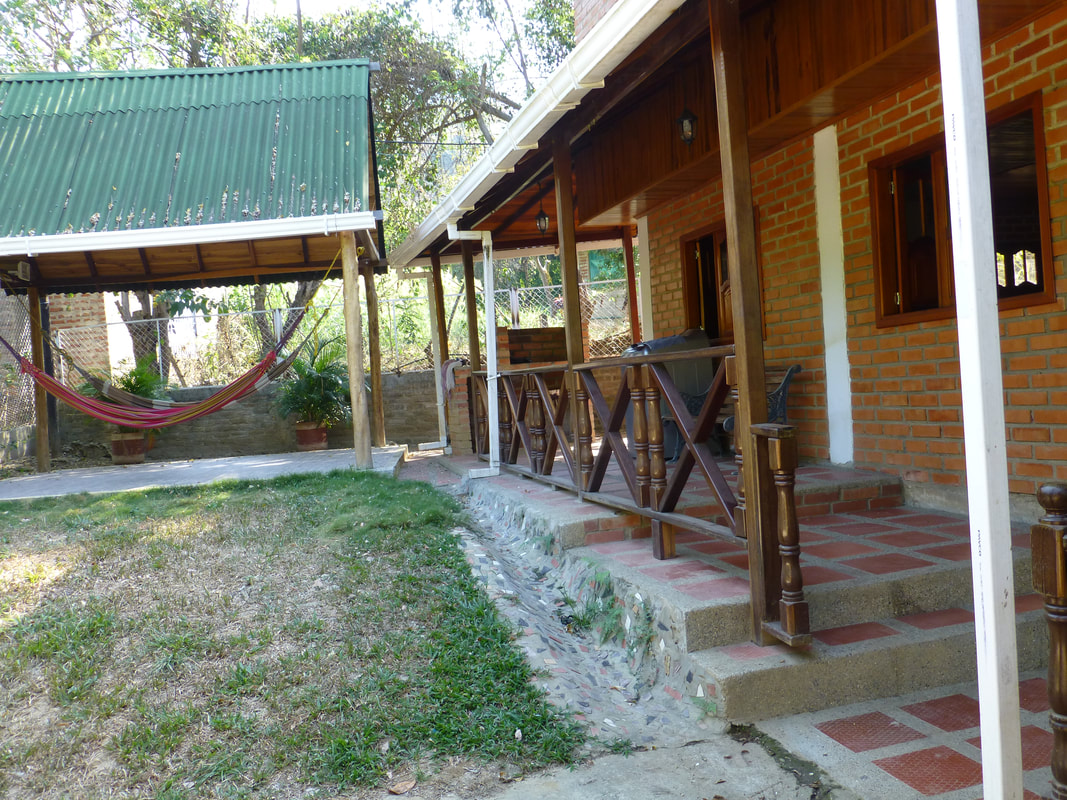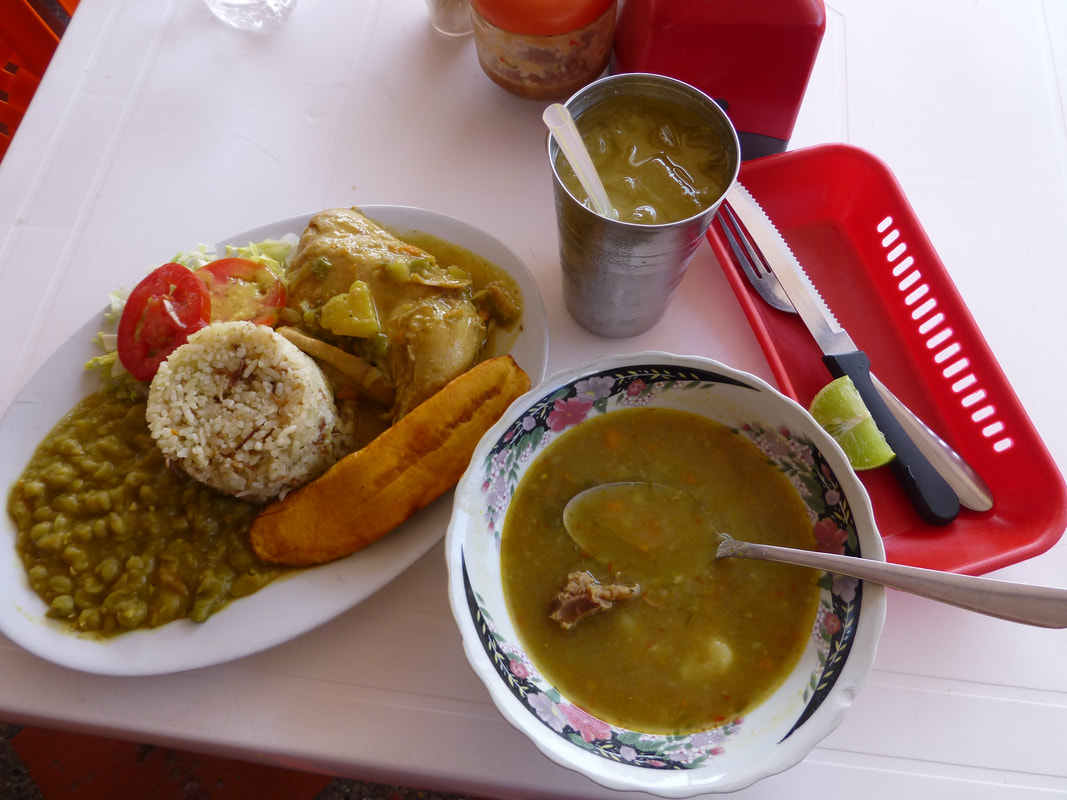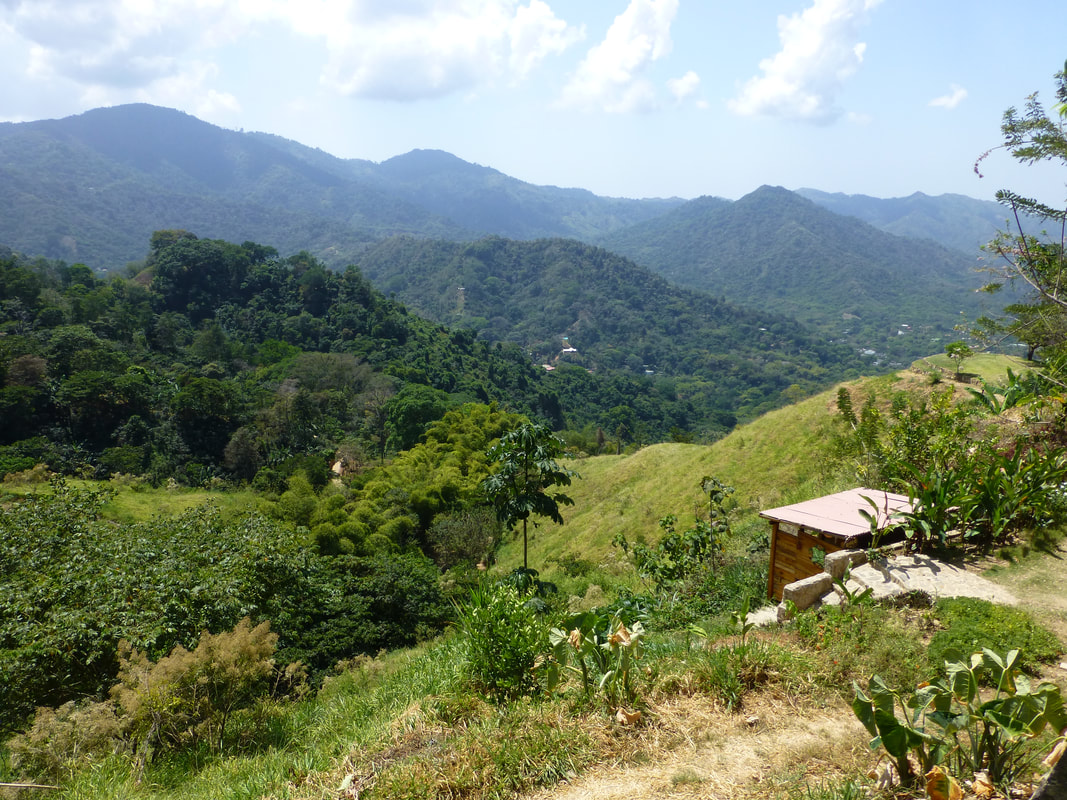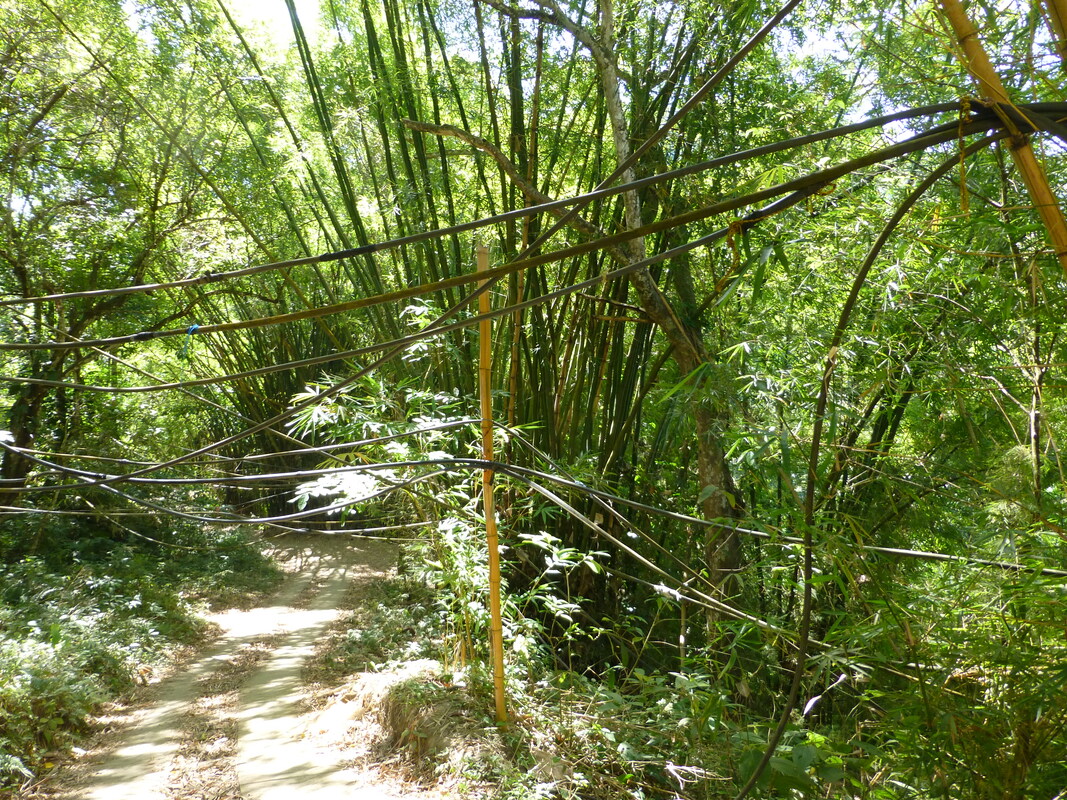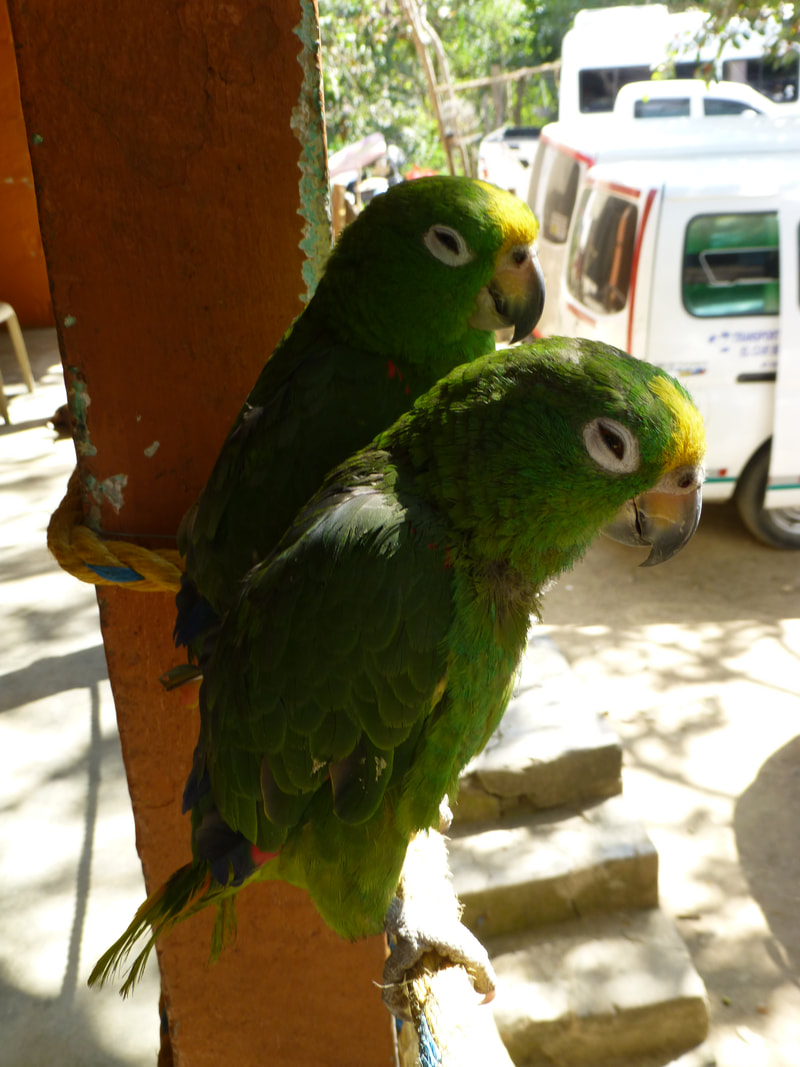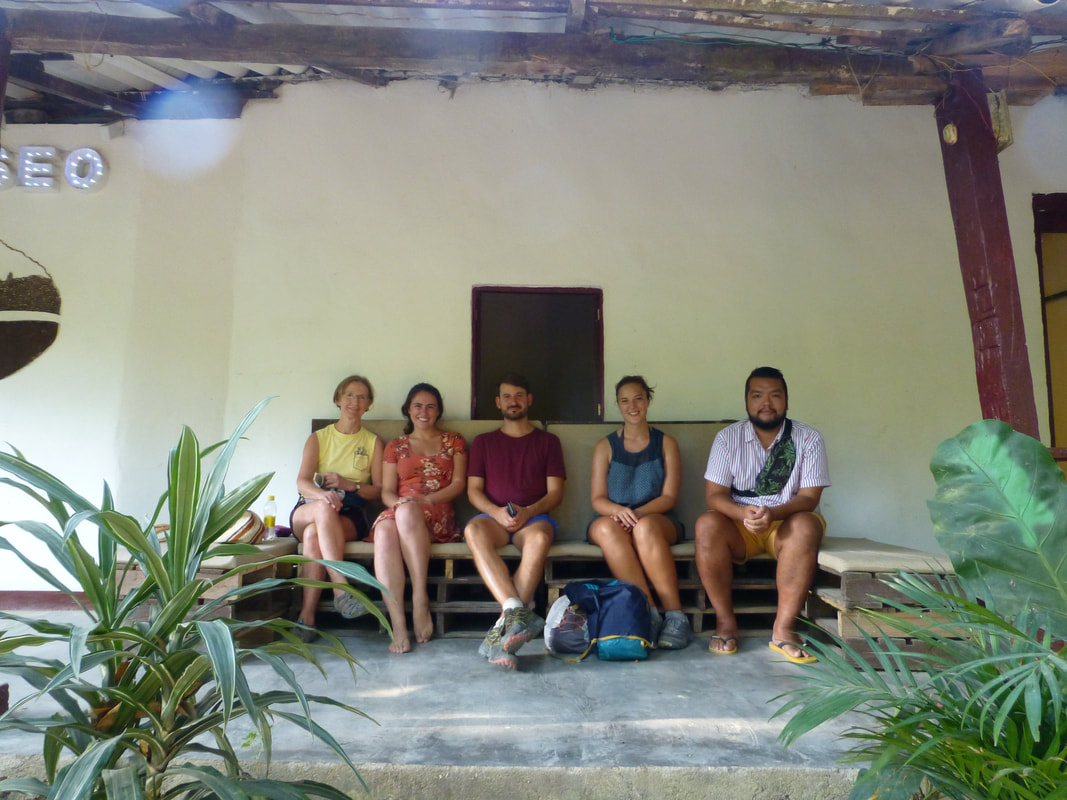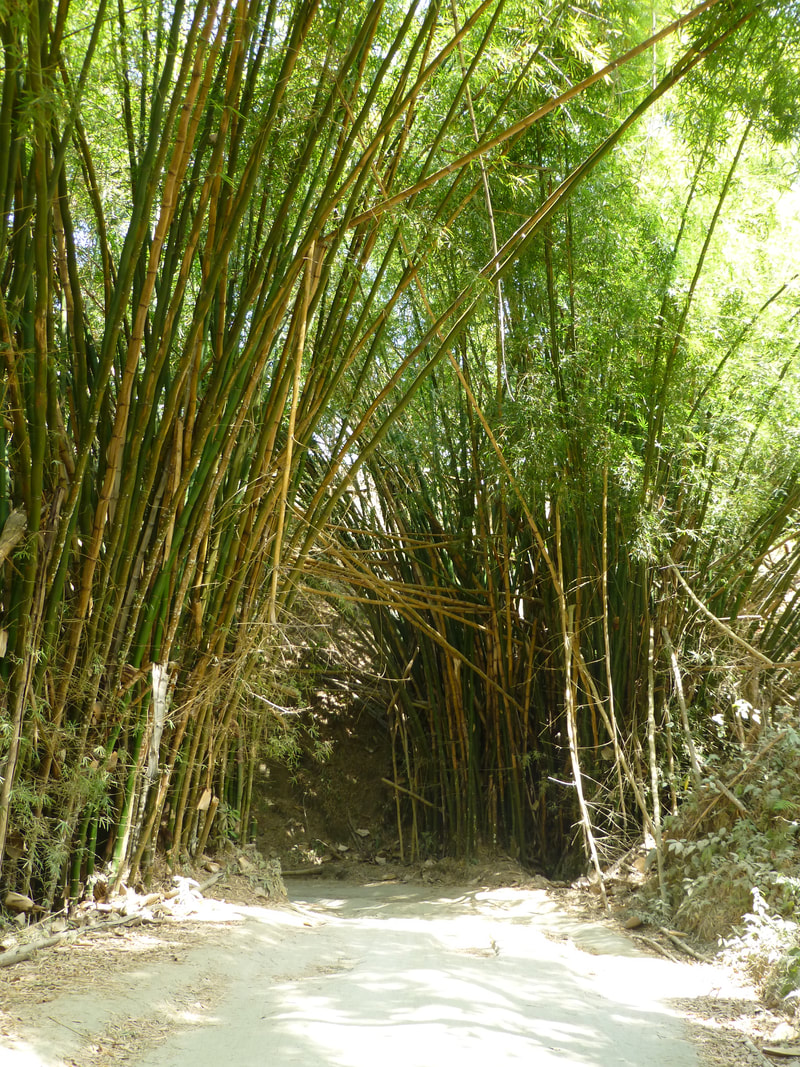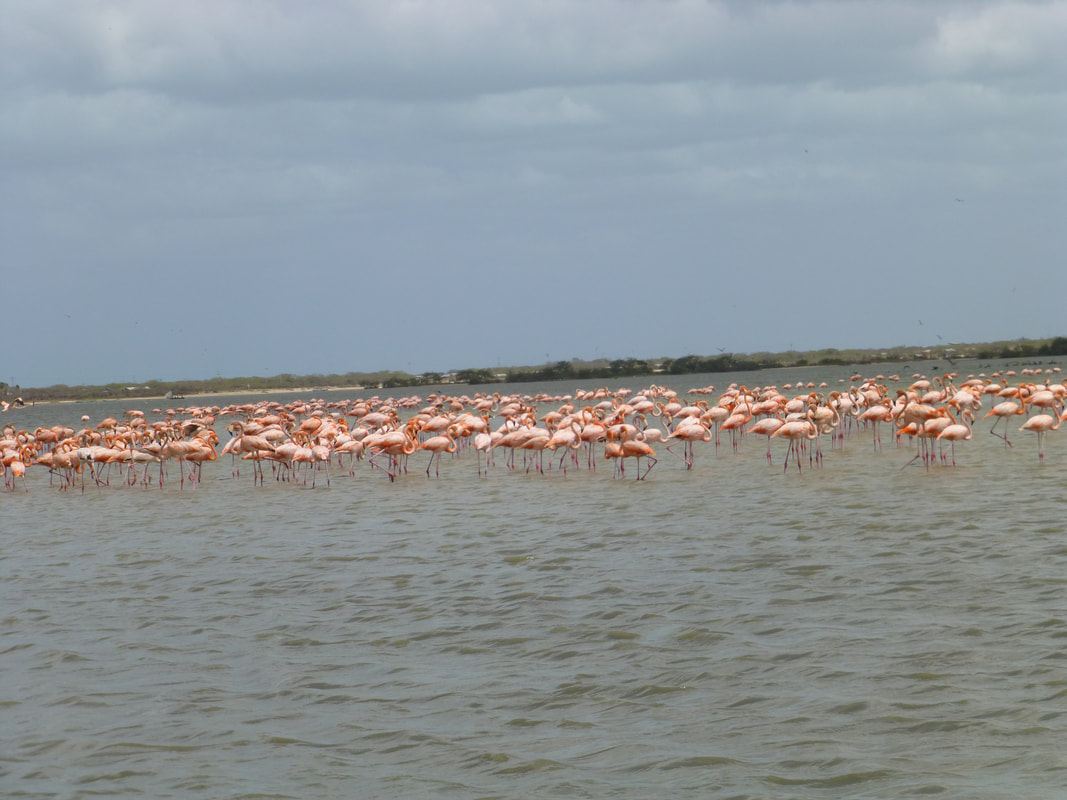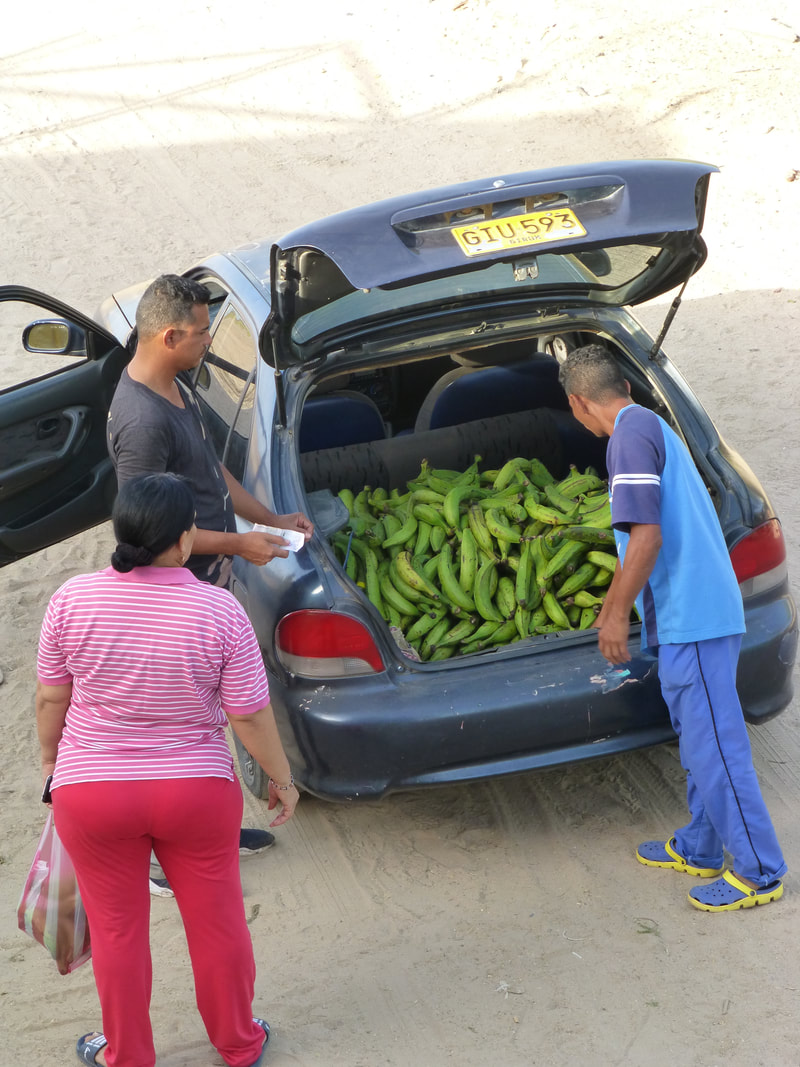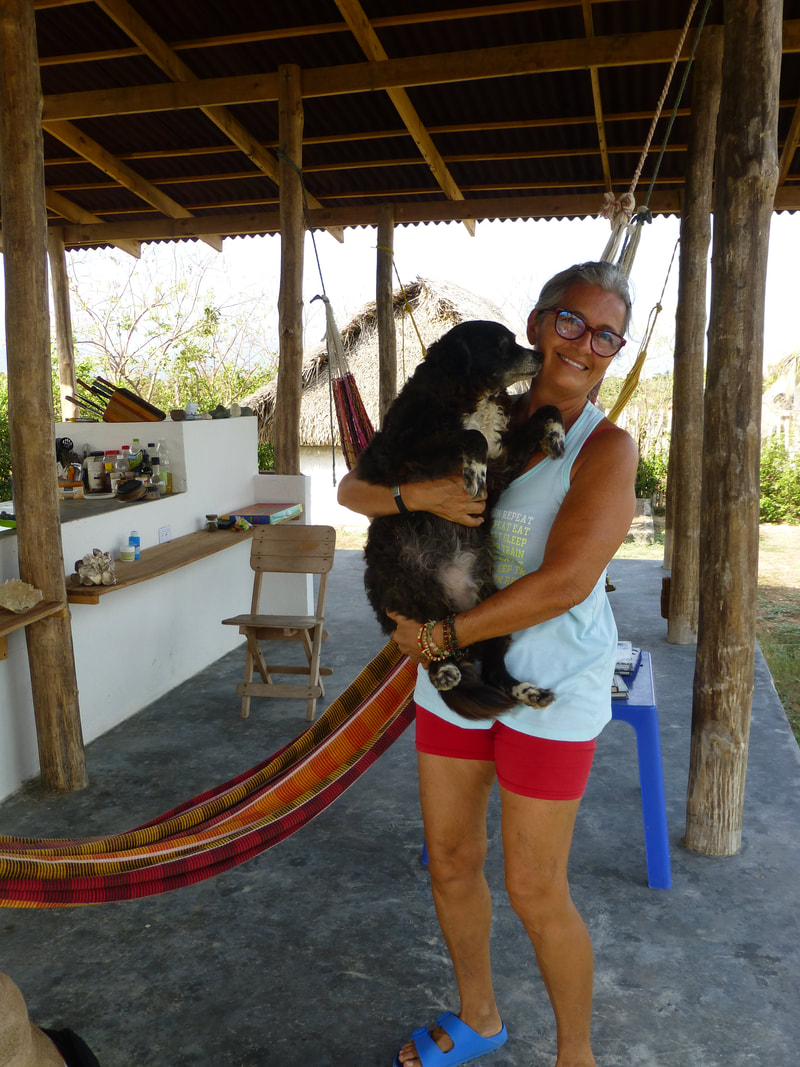In February, 2020 I travelled Vancouver-Toronto-Cartagena and explored the Caribbean coast for 3 weeks, using local transport and staying at airbnbs owned by locals. I was immersed in the culture and language and sent 4 "missives" back to family and friends. Read on if it interests you! - Alison
Missive #1 - Cartagena, Colombia
| February 6, 2020 Hola a todos! I arrived in Cartagena, Colombia after a 2-leg trip from Vancouver to Toronto to Cartagena. Only 12 hrs but tiring in the ever-reducing space of Economy class. I was glad to be on my feet even just to join the long snake of travellers waiting to clear Customs. Sara, my Airbnb hostess was patiently waiting for me holding up a paper with my name. We walked together to her "edificio entre palmas" (building between palm trees), just blocks away from a major international airport. I have her bedroom which is sparse, clean and comfortable with a pedestal fan operating all night to alleviate the 24-hr heat (>30). Cartagena - Guillotine in Museum of the Inquisition The walled city was built 400 years ago by the Spanish against attacks from the English and pirates. Original buildings remain, including the museum of the Inquisition dating from the 1700s. I spent a couple of hours exploring the exhibits, also enjoying the AC and access to bathrooms! Then the cruise ship arrived and 2000 Germans delivered, prey to swarms of street vendors, taxi drivers and tour guides. I sought shade & ended up in conversation with an underemployed locals also seeking relief from the sun. I gave 10,000 Colombian pesos (about CAD$4.50) to a young woman with 2 small children, an economic refugee from Venezuela. I spoke to a Colombian about her later and he said she would be picked up by police if discovered. | Typical "comida del dia" (meal of the day) in Colombia: stewed chicken, rice, beans, plantain and soup with juice made of tamarind ("tomate del arbol) Sara works for the Ministry of Foreign Affairs and rises early to take a "colectivo" (shared taxi) into the Centre. She shares a small 3-bdr apt with her youngest daughter Natalia, just finishing high school and her mother, also Sara, and about my age. Yesterday I caught a colectivo to the old walled city of Cartagena, a big tourist attraction and local source of pride. Transport is a confusing melange of taxis, buses, scooters and pedicabs. Each has it's own transaction vocabulary and pickups and prices are organised in local fashion, not evident to a visitor. It would be difficult to cope solo without spanish. View of roofs from my window As in all of Latin America there is significant poverty and the average Colombian earns USD$100 - 300 per month. However beggars are few, most of them elderly or handicapped. Many survive as vendors and ply the streets continuously for a few pesos. In contrast, the beachfront is lined with luxury hotel and condo towers with more in construction. Pace of life is slow, people are ready to chat, and I've been treated honestly and fairly. Today I take the bus to Baranquilla, about 120 km NE of Cartagena. I have arranged airbnb accommodation for the next 4 nights and then will work it out as I go. I may escape this heat and head into the hills after Santa Marta. |
Missive #2 - Baranquilla to Santa Marta
| February 11, 2020 It's very interesting being here and I appreciate my new experiences, especially of the people who are welcoming and honest. I don't require packaged entertainment as it is adventure enough arranging daily transport, meals and errands. Accommodation is the easiest as I book through Airbnb online, a few days ahead, paying by Paypal. Average cost is CAD$14 - 18, in local homes with private room and bathroom and use of kitchen. I'm very grateful for my Spanish; in fact it is essential for the numerous interchanges that make solo travelling less lonely and bewildering. There is still a lot of strangeness but I try to be self-aware rather than self-conscious, constantly review my cultural bias and marvel at human diversity. The first thing I'm asked is "are you travelling alone", then looks of concern when I respond with a yes. It's not any dangers that preoccupy them, but that I'm not surrounded by family. Bamboo suspension bridge My experiences diverge hugely from those promised in the tourist literature. I haven't yet found the eco-paradise or the caribbean tranquility. Cartagena, Barranquilla, a million each and Santa Marta at 500,00 feel crowded and underserviced. Parks are rare and in order to sit down you use the curb, a cafe or find a church. Narrow, disintegrating sidewalks teem with vendors, stalls, carts, bicycles, even the occasional burro. Everybody is selling something and they are at it 7 days a week from dawn to dusk. I'm mystified how they make enough to survive with so much competition. Sierra Nevada | Water lines through the jungle from upstream So far I haven't located a paper map and I don't have a cell phone with GPS so I depend heavily on my laptop & google maps. Providentially I packed some post-its and use them to draw miniscule maps for use the following day. However, they have limited utility as once on the street, signs are rare, roads serpentine and traffic chaotic, noisy and constant. Today I found a currency exchange in a sweets shop - no signage; a helpful local effected this miracle. Bicycle-powered blender I am now in Minca. Caught a minibus from Santa Marta for an hour's ride up a sinous road into the Sierra Madre. I have an incredible place to stay built of brick and wood with patio outside with hammocks and a big wooden gate that is more show than function. The owner, Javier is absent and leaves the management to Gisel, Michel and Lorena, 3 sisters who live with more extended family in a concrete dwelling across the dirt lane. I sat with them a while yesterday, after walking to Pozo Azul the long way. I had simply set off with waist pack carrying water, camera and some money. The trail became narrower and steeper passing groves of 40+ ft bamboo, draping vines, unknown species of hardwoods. Plastic water pipes threaded through the trees serving residents who carved out a livlihood in the bush with chickens, coffee and gardens. After ascending for 3/4 hr I started to descend and fortunately met a German with cellphone, GPS and Maps.me who assured me I was still on track. Passed a hydroponic lettuce farm, crossed a bamboo bridge and miraculously found the more direct route to Pozo Azul. Of course there were vendors here too and en route I enjoyed "tinto" (black coffee with lots of sugar, NOT made from instant), a homemade "helado" (popsicle) made from lulo, a yet unknown fruit, and grilled plantain with guayaba and cheese on top. I think I could stay here a while! |
Missive #3 - Minca, in the Sierra Nevada
| Scoffing at the tourists | Hello again! I've now found what I came to Colombia for; a small town with the modest amenities I need, safe, with river, jungle, birds and little english spoken. I arrived here after Cartagena, Barranquilla and Santa Marta, all of them too frenetic, hot and noisy. The heat continues and I cool the room with a fan that also blows away the occasional mosquito. My legs are peppered with red, slightly inflamed bites from the minute sandflies Arrived in Minca on monday via a 21 km narrow, winding road from Santa Marta into the Sierra Nevada. The paved road ended where the minibus stopped and from the village only rutted dirt tracks best suited to walking and motos (motorbikes). I walked to Casa de los Pinos and Lorena, Javier's neighbour & caretaker of the house gave me keys for both the house and my bedroom. It is 2-storey dwelling of brick and wood with decorative shuttered windows (no glass or screen), patio outside with hammock, modern bathroom with 1 tap in the shower (typical) and tidy kitchen with gas stove and full fridge. Once I saw it I already had plans to stay longer! |
| 2I'm gratified to allow each day to unfold as it will. I set off with water, hat, maybe a piece of fruit and some money, and find my nourishment, both alimentary and educatively en route. Yesterday I ended up at Finca San Rafael, a coffee and cacao (chocolate) farm about 40-minute walk along the flank of hills. Joined a tour led by an Irishman and which included visitors from Australia, England, Switzerland, Italy, Brazil, Colombia as well as one aging Canadian. We set off with walking sticks and hats up steep sandy slopes to learn about organic coffee and cacao culture. It was informative and entertaining and we all ended up with chocolate facials. | Chocolate Facials |
| Minca Museum | I am very impressed by a young couple I met in their self-created oral history museum in Minca. Manuel is great grandson of the founder of Minca and Shenandoah is an American-Colombian of partial Iroquois descent. He is a teacher and she has a degree in ethnopolitics. For 4 years they have been gathering photos and stories of the history of the area. The history has been tumultuous and often violent and I listened fascinated as Shennan wove the story from pre-colonial times to current precarious stability. |
| 3The Sierra Nevada is the closest mountain range to the sea in the world (Canada comes a close 2nd). This allowed the Indians to escape from the marauding Spanish & pirates further into the hills where they have lived for millenia. (Lost City). Colombia gained independence from Spain after 1810 and disrupted into civil conflict for decades after, the most significant being the 1000 days war Coffee likely arrived with the Jesuits in the 1700s but plants were abandoned and then rediscovered by an English and a Swiss engineer contracted to develop the first hydroelectric plant in Colombia. They got diverted by the quality of the beans, had them tested and abandoned their original project to start coffee farms. Minca has been abandoned and repopulated a number of times. Manuel remembers as a child, watching 2 guerrilla groups shooting it out in the clearing in front of his parent's house (the current museum). Nobody knew how many were killed as all the bodies were carried away, but the street ran with blood. Then the brutal paramilitary groups, originally formed to fight the left-leaning guerrillas but eventually brutalising everybody, funded from drug-trafficking and aided by the US government. Through it all, ordinary people tried to hide but eventually left the area or took sides, sometimes both sides in an unclear conflict. (I recall Alan telling me a similar story of Afghani villagers with members on both sides of their conflict - a survival strategy). El Mundo Nuevo Eco-lodge We've had a power outage for the past few hours, a not uncommon occurrence here. It reminds the local populace of the times when the guerrilla groups would come down from the mountains and cut the electric lines to avoid identification in the dark. Everyone stayed inside, very quiet until the sun rose again. Now it's not guerrillas, but inadequate infrastructure (I think). I sat outside the house as darkness fell, talking to the 3 sisters who are my neighbours. They are from Venezuela, sharing a house of 2 rooms with 5 other persons, no electricity or running water. They came to my house to power their phones and want me to pack them away to Canada. | Bamboo Grove 4Now, Colombia is ostensibly a democracy with two factions, both corrupt. Uribe pulls the strings behind the current President as his party systematically undoes any improvement implemented by previous president Santos. Today is the first day of the ELN (National Liberation Army) armed strike ("Paro"), part of ongoing protests to support the poor, fight corruption, and pressure for political change, but also aggravating distrust and fear in communities. Transport and schools here are affected but what else I'm not sure. Minibuses back to Santa Marta are still operating and my plan is to leave tomorrow morning and head for Palomino, further up the Caribbean coast. This morning I once again set off without fixed destination and after sweating up a steep, dusty track for an hour, reached Mundo Nuevo eco-lodge and organic coffee farm. I've included photos of buildings, views and indigenous dwellings in the link above. The 4 groups of indians here are well-respected; they see themselves as guardians of the earth and call themselves Hermanos mayores (big brothers). We others who are destroying it with our vast consumption and greed are Hermanos menores (little brothers) who need guidance and direction. There is a wonderful BBC film called Aluna (in english!) which describes their way of life. Hammock verandah |
Missive #4
| Trip is winding down as I approach the day of my return flights from Cartagena to Toronto and then to Vancouver (Feb 25). When I last wrote I was in Minca, in the foothills of the Sierra Nevada, Department of Magdalena. From Minca I took a mini-bus to the outskirts of Santa Marta and from there caught a bus to Palomino, in the most NE Department of Colombia called "La Guajira". It is a coastal village, now bustling with hostels, comedors (restaurants) and vendors of every type. It took a while for me to find my accommodation as the Airbnb map was incorrect and I have neither cellular nor map. With help I finally met Camilo outside her metal portón (high locked metal door to private compound). I was tired and hot (35+C) and was glad I just had the carry-on pack and waist pack with me. As it is, I've hardly used any of my clothes, just alternate between 2 pairs of shorts and 2 tank tops. When I fly back I'll put on a few more layers after Toronto. Outdoor kitchen in Dibulla From Palomino I caught a "colectivo" to Mingeo, about an hour east along the carretera (2-lane highway). The driver didn't leave Palomino until he had his complement of 4 passengers. No seat belts, odometer or speedometer (I was in the front passenger seat), and a lack of muffler nulled conversation. Caught another "puerta a puerta" (door to door) on the main street that delivered me to my next bnb, a casita (little house) in Dibulla. I'm moving from small to smaller and here I stayed an extra night as it was clean, peaceful and I had a very pleasant hostess, Mercedes Helena, a retired lawyer from Medellin. Flamingos - Boca de Camerones, La Guajira From Dibulla I travelled to Camerones ("Shrimp"), catching another puerta a puerta in a newer car this time. The driver was surprised when I stopped him as he was driving past the turnoff to Camarones en route the the Department capital of Rioacha ("Axe river"). "Pero aqui no hay nada!" (but there's nothing here!) said the young woman who shared the backseat with me. Indeed she was right - the hostel was closed and I ended up riding on "moto" (motorscooter, no helmut, my backpack carried as frontpack by the driver) to Boca de Camarones, the beach community close to the Flamingo sanctuary that drew me there in the first place. I found another hostel, habitable with toilets that flush and a shower (pipe from wall, no head, one tap). Plantain bartering | Alison and Camilo (Palomino) I walked down the main dirt road past eager vendors with few clients, to the beach, now much reduced by risen tides, both a seasonal and climate change phenomena. Many coco trees along the ocean are undermined by the surf, others fallen and then chopped to create a surf barrier with sandbags. Palomino is skirted by 2 rivers and I walked to both, enjoying refreshing swims but puncturing my foot with a coco root en route. It has been slow to heal and I'm glad I didn't dispose of my dilapidated shoes earlier in the trip. Camilo had a friend, Carlos, visiting from Bogotá and the last morning over breakfast (arepas, eggs, plantain) we discovered that we all shared the same birth year. I learned a lot more about Colombia from them and Carlos affirmed what the Minca couple told me about the current gov't with its strong ties to the paramilitary. There is little trust in governing officials here; everyone refers to corruption, but lips are tight on specifics as you can't be sure who you are talking to. Tourists are relatively safe, as income from their expenditures is badly needed. Mercedes Helena & Luna - Dibulla, La Guajira Here there is a dire shortage of water, both for washing and potable. Boca de C has saline lagoon on one side and full surf ocean on the other. The Department of La Guajira is dry tropical forest, becoming desert in the extreme NE. Dry season (now) can last up to 5 months. Water is extracted from the diminishing rivers by bucket or pump to tanks and sold in the same manner. I accompanied a group of locals to a local river to haul water back to the town. We used buckets to fill 2 huge containers in the back of a pickup and then combed back streets selling it to their relatives. I've included some photos of this area including my "tour" to see the flamingos feeding on shrimp in the middle of the lagoon. Sailing on Lagoon - Boca de Camerones Now I'm back in Santa Marta in comparable luxury in a 10-bed dorm with pool outside (albeit very small) and breakfast included. I've just had a long interesting conversation with Apo (31) from Turkey and had breakfast with Nina from Germany. She told me her trials trying to get a rabies shot after getting bitten by a dog in the Amazon. I'm luck; just my left foot throbs, now with a swollen blue toe (suspect broken or at least cracked) in addition to puncture. We both commiserated on the miserable pieces of cardboard that pass for bread here - but at least it's not corn! |

